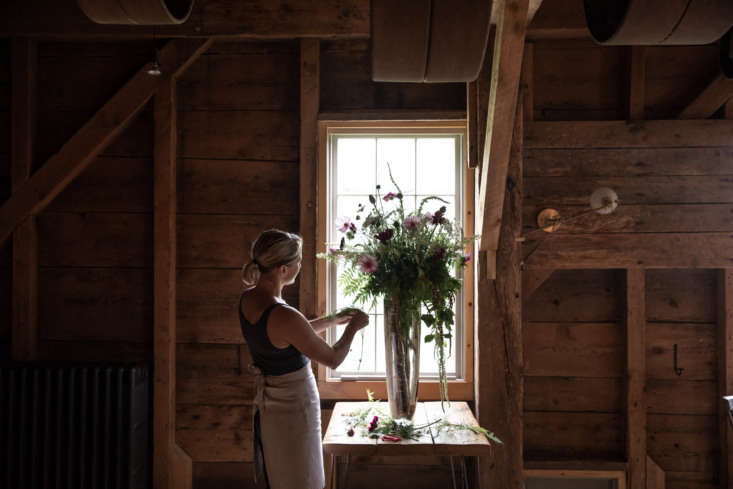When I reach Erin French by phone to talk about her flower-arranging tips, she’s holding the phone in one hand and twining vines and arranging flowers for her own wedding, which is happening this weekend, with the other. It’s a prime example of how French works: The self-taught chef behind The Lost Kitchen, the country’s wildly successful restaurant of the moment, does nearly everything—from cooking multicourse meals to arranging the flowers to building the tables—herself.
The Lost Kitchen is an unlikely success story (you can read the full version in A Glimpse Inside Maine’s Most Wildly In-Demand Restaurant on Remodelista). French started it as an underground supper club in her Maine apartment, then opened a brick-and-mortar location, which she lost in a contentious divorce. She started again, serving elaborate dinners out of a renovated Airstream parked in the meadows and woods of Maine, before setting up shop in an old mill in the tiny, rural town of Freedom, Maine (“population: 719” French writes in her cookbook). There, French cooks multicourse meals with no menu in mind, drawing only from what’s available and recipes learned from her mother and grandmother. This year, nearly 20,000 people mailed in postcards—the only way to get a seat—for a chance at a table.
Somehow, French finds time in the midst of all of this to create wild, dramatic arrangements for the dining room each evening. “This is my little joy time, when I step away from the stove,” she told me on a recent day when I drove north to Freedom to watch her at work. Here are a few of the tricks up her sleeve.
Photography by Greta Rybus for Gardenista.

1. Winnow down your choices.


“It’s really knowing what flowers you love,” French says, explaining that sometimes she’ll just focus on one flower—like lupines. “One thing on its own looks really great,” she says.
2. Buy vases for a song.

3. Use birch logs as an anchor.

(Tip: “I made the mistake of drying out the logs in the off-season,” French says. They need to be kept wet all the time in order to avoid them bobbing up to the top of the vase: Keep them covered with water in the vase, even when they’re not in use.)
4. Start with filler.

5. Follow the rule of odds.

6. Let the flowers capture a mood.

Tip: “Add a little bleach to the water to keep it clean and clear,” French advises. “Flowers will last longer too! Kills bacteria!”
7. Keep pruners in your car (and know where the best lilac bushes are).

(Pictured: a small arrangement for the downstairs wine shop by French’s mom, Deanna.)
8. Do it yourself.

French is doing all of the arrangements for her own wedding, with help from Savage, who’s providing the flowers. “I’m sure most brides plan this out years in advance and have Pinterest boards,” French tells me. Instead, her wedding is sure to have all the wild elegance of the Lost Kitchen: French walked through Savage’s farm to choose flowers a few days ago, selecting “big old vintage plants growing up with the ragweed and ferns poking up in the woods,” she says. “We have little apothecary bottles that we’re using, and we’ve been collecting wine bottles from the restaurant and taking the labels off,” tucking ferns and candles inside, she says.

For more secrets to the elusive art of flower arranging, see our Rethinking Flowers posts, as well as:
- Flower Arrangements 101: A Crash Course for Easy and Elegant Florals
- DIY: Flowers in the House, 9 Ways
- Flower Arranging 101: Effortless Takes Effort
- Flower Arranging 101, or Lessons in Humility















Have a Question or Comment About This Post?
Join the conversation (0)